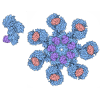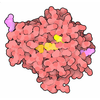+ Open data
Open data
- Basic information
Basic information
| Entry | Database: PDB / ID: 9hr6 | |||||||||||||||||||||||||||
|---|---|---|---|---|---|---|---|---|---|---|---|---|---|---|---|---|---|---|---|---|---|---|---|---|---|---|---|---|
| Title | cryoEM structure of amyloid fibrils formed by human RIPK1 | |||||||||||||||||||||||||||
 Components Components | Receptor-interacting serine/threonine-protein kinase 1 | |||||||||||||||||||||||||||
 Keywords Keywords | PROTEIN FIBRIL / Amyloid / kinase | |||||||||||||||||||||||||||
| Function / homology |  Function and homology information Function and homology informationripoptosome assembly / positive regulation of miRNA processing / positive regulation of interleukin-6-mediated signaling pathway / ripoptosome assembly involved in necroptotic process / death domain binding / peptidyl-serine autophosphorylation / ripoptosome / Defective RIPK1-mediated regulated necrosis / Microbial modulation of RIPK1-mediated regulated necrosis / TRIF-mediated programmed cell death ...ripoptosome assembly / positive regulation of miRNA processing / positive regulation of interleukin-6-mediated signaling pathway / ripoptosome assembly involved in necroptotic process / death domain binding / peptidyl-serine autophosphorylation / ripoptosome / Defective RIPK1-mediated regulated necrosis / Microbial modulation of RIPK1-mediated regulated necrosis / TRIF-mediated programmed cell death / Regulation by c-FLIP / CASP8 activity is inhibited / Dimerization of procaspase-8 / TLR3-mediated TICAM1-dependent programmed cell death / TNF signaling / programmed necrotic cell death / Caspase activation via Death Receptors in the presence of ligand / SARS-CoV-1-mediated effects on programmed cell death / positive regulation of macrophage differentiation / JUN kinase kinase kinase activity / T cell apoptotic process / necroptotic signaling pathway / NF-kB activation through FADD/RIP-1 pathway mediated by caspase-8 and -10 / death-inducing signaling complex / RIP-mediated NFkB activation via ZBP1 / positive regulation of necroptotic process / negative regulation of necroptotic process / positive regulation of tumor necrosis factor-mediated signaling pathway / death receptor binding / positive regulation of programmed cell death / positive regulation of programmed necrotic cell death / positive regulation of extrinsic apoptotic signaling pathway / TNFR1-induced proapoptotic signaling / RIPK1-mediated regulated necrosis / TRP channels / necroptotic process / response to tumor necrosis factor / positive regulation of execution phase of apoptosis / canonical NF-kappaB signal transduction / negative regulation of extrinsic apoptotic signaling pathway in absence of ligand / extrinsic apoptotic signaling pathway / signaling adaptor activity / negative regulation of canonical NF-kappaB signal transduction / TICAM1, RIP1-mediated IKK complex recruitment / IKK complex recruitment mediated by RIP1 / tumor necrosis factor-mediated signaling pathway / TNFR1-induced NF-kappa-B signaling pathway / positive regulation of interleukin-8 production / negative regulation of extrinsic apoptotic signaling pathway / positive regulation of JNK cascade / Regulation of TNFR1 signaling / protein catabolic process / positive regulation of non-canonical NF-kappaB signal transduction / positive regulation of NF-kappaB transcription factor activity / cellular response to growth factor stimulus / Regulation of necroptotic cell death / cellular response to hydrogen peroxide / positive regulation of protein phosphorylation / positive regulation of reactive oxygen species metabolic process / positive regulation of inflammatory response / positive regulation of tumor necrosis factor production / cellular response to tumor necrosis factor / Ovarian tumor domain proteases / positive regulation of neuron apoptotic process / protein autophosphorylation / response to oxidative stress / amyloid fibril formation / Potential therapeutics for SARS / positive regulation of canonical NF-kappaB signal transduction / non-specific serine/threonine protein kinase / receptor complex / protein kinase activity / endosome membrane / Ub-specific processing proteases / intracellular signal transduction / positive regulation of apoptotic process / inflammatory response / protein serine kinase activity / protein serine/threonine kinase activity / apoptotic process / ubiquitin protein ligase binding / positive regulation of gene expression / negative regulation of apoptotic process / protein-containing complex binding / protein homodimerization activity / positive regulation of transcription by RNA polymerase II / protein-containing complex / mitochondrion / ATP binding / identical protein binding / plasma membrane / cytoplasm / cytosol Similarity search - Function | |||||||||||||||||||||||||||
| Biological species |  Homo sapiens (human) Homo sapiens (human) | |||||||||||||||||||||||||||
| Method | ELECTRON MICROSCOPY / helical reconstruction / cryo EM / Resolution: 2.57 Å | |||||||||||||||||||||||||||
 Authors Authors | Lopez-Alonso, J.P. / Ubarretxena-Belandia, I. / Jiang, H. | |||||||||||||||||||||||||||
| Funding support |  Spain, 1items Spain, 1items
| |||||||||||||||||||||||||||
 Citation Citation |  Journal: To Be Published Journal: To Be PublishedTitle: Molecular Structure of Human Receptor Interacting Protein Kinase 1 (RIPK1) in its Fibrillar Conformation Elucidated by Solid-State NMR and Cryo-Electron Microscopy Authors: Polonio, P. / Lopez-Alonso, J.P. / Ubarretxena-Belandia, I. / Jiang, H. / Escobedo-Gonzales, F.C. / Titaux-Delgado, G.A. / Mompean, M. | |||||||||||||||||||||||||||
| History |
|
- Structure visualization
Structure visualization
| Structure viewer | Molecule:  Molmil Molmil Jmol/JSmol Jmol/JSmol |
|---|
- Downloads & links
Downloads & links
- Download
Download
| PDBx/mmCIF format |  9hr6.cif.gz 9hr6.cif.gz | 35.9 KB | Display |  PDBx/mmCIF format PDBx/mmCIF format |
|---|---|---|---|---|
| PDB format |  pdb9hr6.ent.gz pdb9hr6.ent.gz | 22.1 KB | Display |  PDB format PDB format |
| PDBx/mmJSON format |  9hr6.json.gz 9hr6.json.gz | Tree view |  PDBx/mmJSON format PDBx/mmJSON format | |
| Others |  Other downloads Other downloads |
-Validation report
| Summary document |  9hr6_validation.pdf.gz 9hr6_validation.pdf.gz | 1 MB | Display |  wwPDB validaton report wwPDB validaton report |
|---|---|---|---|---|
| Full document |  9hr6_full_validation.pdf.gz 9hr6_full_validation.pdf.gz | 1 MB | Display | |
| Data in XML |  9hr6_validation.xml.gz 9hr6_validation.xml.gz | 34.5 KB | Display | |
| Data in CIF |  9hr6_validation.cif.gz 9hr6_validation.cif.gz | 45.9 KB | Display | |
| Arichive directory |  https://data.pdbj.org/pub/pdb/validation_reports/hr/9hr6 https://data.pdbj.org/pub/pdb/validation_reports/hr/9hr6 ftp://data.pdbj.org/pub/pdb/validation_reports/hr/9hr6 ftp://data.pdbj.org/pub/pdb/validation_reports/hr/9hr6 | HTTPS FTP |
-Related structure data
| Related structure data |  52356MC M: map data used to model this data C: citing same article ( |
|---|---|
| Similar structure data | Similarity search - Function & homology  F&H Search F&H Search |
- Links
Links
- Assembly
Assembly
| Deposited unit | 
|
|---|---|
| 1 |
|
- Components
Components
| #1: Protein | Mass: 9656.604 Da / Num. of mol.: 5 Source method: isolated from a genetically manipulated source Source: (gene. exp.)  Homo sapiens (human) / Gene: RIPK1, RIP, RIP1 / Plasmid: pET11a / Production host: Homo sapiens (human) / Gene: RIPK1, RIP, RIP1 / Plasmid: pET11a / Production host:  References: UniProt: Q13546, non-specific serine/threonine protein kinase Has protein modification | N | |
|---|
-Experimental details
-Experiment
| Experiment | Method: ELECTRON MICROSCOPY |
|---|---|
| EM experiment | Aggregation state: HELICAL ARRAY / 3D reconstruction method: helical reconstruction |
- Sample preparation
Sample preparation
| Component | Name: hRIPK1 RHIM-mediated amyloid fibril / Type: COMPLEX / Entity ID: all / Source: RECOMBINANT |
|---|---|
| Source (natural) | Organism:  Homo sapiens (human) Homo sapiens (human) |
| Source (recombinant) | Organism:  |
| Buffer solution | pH: 7.5 |
| Buffer component | Conc.: 50 mM / Name: TrisHCl |
| Specimen | Conc.: 0.765 mg/ml / Embedding applied: NO / Shadowing applied: NO / Staining applied: NO / Vitrification applied: YES |
| Specimen support | Details: 9 mA / Grid material: GOLD / Grid mesh size: 300 divisions/in. / Grid type: UltrAuFoil R1.2/1.3 |
| Vitrification | Instrument: FEI VITROBOT MARK IV / Cryogen name: ETHANE / Humidity: 100 % / Chamber temperature: 277 K / Details: time 5.5s, blotting force 2 |
- Electron microscopy imaging
Electron microscopy imaging
| Experimental equipment |  Model: Titan Krios / Image courtesy: FEI Company |
|---|---|
| Microscopy | Model: TFS KRIOS |
| Electron gun | Electron source: LAB6 / Accelerating voltage: 300 kV / Illumination mode: FLOOD BEAM |
| Electron lens | Mode: BRIGHT FIELD / Nominal magnification: 165000 X / Nominal defocus max: 1600 nm / Nominal defocus min: 800 nm / Cs: 2.7 mm / C2 aperture diameter: 50 µm / Alignment procedure: COMA FREE |
| Specimen holder | Cryogen: NITROGEN / Specimen holder model: FEI TITAN KRIOS AUTOGRID HOLDER |
| Image recording | Average exposure time: 0.88 sec. / Electron dose: 49.3 e/Å2 / Film or detector model: GATAN K3 BIOCONTINUUM (6k x 4k) / Num. of grids imaged: 1 |
| Image scans | Width: 5760 / Height: 4092 |
- Processing
Processing
| EM software |
| ||||||||||||||||||||||||||||||||||||
|---|---|---|---|---|---|---|---|---|---|---|---|---|---|---|---|---|---|---|---|---|---|---|---|---|---|---|---|---|---|---|---|---|---|---|---|---|---|
| CTF correction | Type: PHASE FLIPPING AND AMPLITUDE CORRECTION | ||||||||||||||||||||||||||||||||||||
| Helical symmerty | Angular rotation/subunit: -7.319 ° / Axial rise/subunit: 4.667 Å / Axial symmetry: C1 | ||||||||||||||||||||||||||||||||||||
| Particle selection | Num. of particles selected: 2814672 | ||||||||||||||||||||||||||||||||||||
| 3D reconstruction | Resolution: 2.57 Å / Resolution method: FSC 0.143 CUT-OFF / Num. of particles: 460173 / Num. of class averages: 1 / Symmetry type: HELICAL | ||||||||||||||||||||||||||||||||||||
| Atomic model building | B value: 66.05 / Protocol: FLEXIBLE FIT / Space: REAL | ||||||||||||||||||||||||||||||||||||
| Atomic model building | Details: ModelAngelo using sequence / Source name: Other / Type: in silico model |
 Movie
Movie Controller
Controller




 PDBj
PDBj









 Coot
Coot